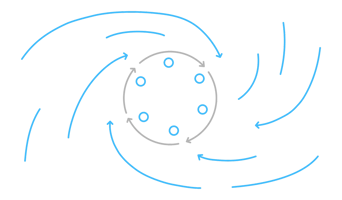There are seven key value-creating tasks and responsibilities that any team leader who wants to build and lead a high-performing team must do.
In leading teams, there are basically two different kinds of tasks and responsibilities.
-
First, there is a mechanistic or administrative set of tasks.
-
And second, there is a strategic and value-oriented set of tasks and responsibilities.
In this post we are mainly interested in the second kind (and, partly, in how the two sets of tasks depend upon one another). The administrative set of tasks is often necessary to the extent that teams are part of bureaucratic structures. However, in terms of supporting high performance, the administrative team leader tasks are largely worthless on their own.
In the mechanistic or administrative set of tasks, the team leader often simply enacts company-wide policies or orders, often set by corporate functions, and often with little influence over the purpose or the goals of those corporate guidelines.
A team leader is responsible for creating conditions so that the team can perform at its best
On the other hand, because a team leader owns the value-oriented or strategic set of tasks, they are responsible for creating the conditions for a team’s best performance.
This entails a number of specific tasks to build the key elements of high-performing teams. We have tried to break that down into a concrete list of activities and deliverables that collectively supports the development of a high-performing team. Being a team leader means you need to do the following:
-
A team leader has to lead the definition of and the ongoing conversation about the team’s purpose: why are we here, why are doing what we are doing, how are we creating value?
-
A team leader has to set and lead the ongoing monitoring, together with the team, of specific performance goals. She also has to moderate those goals, both with senior and outside stakeholders, as well as with the team itself.
-
A team leader has to work on staffing and capacity and has to make sure that the team’s manpower is in line with its goals and deliverables.
-
A team leader has to make sure her team members have the knowledge, skills, and capabilities they need to collectively reach the team’s goals.
-
A team leader is responsible for setting team rules, discussing and negotiating those rules on an ongoing basis with the team, and modeling her own behavior to exemplify those rules.
-
A team leader has to communicate with his team in a way that leads to productive communication patterns proven to support team effectiveness, and he has to build and maintain relationships with and between team members that facilitate trustful collaboration.
-
A team leader has the prime responsibility of detecting, evaluating and managing tensions and conflicts in her team, and ensuring that those tensions support the team’s purpose and goals or, at the very least, that they do not inhibit the team from reaching its goals.
The Team Kit gives you the knowledge and the guidance to build and lead high-performing teams
Taking care of the fundamentals of high-performing teams is not a question of team leadership styles
A good team leader has to fulfill the above mentioned tasks and responsibilities one way or the other, regardless of her leadership style. On a fundamental level, those responsibilities are independent of styles and personalities.
We have seen many examples of team leadership where the ongoing sensemaking of purpose and goals was done in very different styles and language. But we have not seen any high-performing team where the leader of the group did not somehow facilitate this very conversation.
In addition to the seven tasks and responsibilities detailed above, a team leader is well advised to own some “real” tasks from the team’s set of deliverables (while at the same time delegating some of the genuine team leader tasks to his team members, thereby facilitating shared leadership).
One set of tasks where the team leader is often well positioned to do some “real work” is covering the above mentioned administrative functional tasks resulting from the team’s internal environment.
Just don’t mistake enacting the corporate performance management processes and writing appraisals with the seven value-creating team leader responsibilities discussed above!



